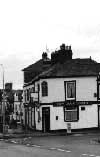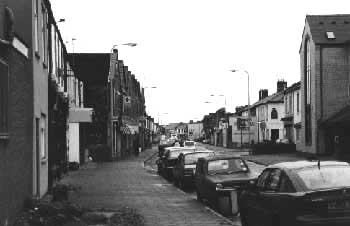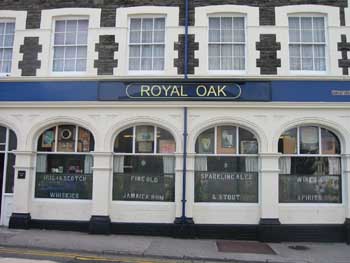|

Read
about
Real Cardiff
Broadway
Bute Street
Charles Street
City Road
Flat Holm
The Four Elms
The Garth
Gorsedd Gardens
Hadfield Road
Kardomah
Lloyd George Ave
Mount Stuart Square
Newport Road
Newtown
The Parks of Roath
The Pearl
Whitchurch
Common
Womanby St.
Cardiff
Poets Map
Cardiff,
New York
Shots
of the Bay
and the City
More
Scenes
Cardiff
Fictions and
Creative
autobiographies
Poems
Hamadryad Park
Ely
The Bay
St David's Hall
The Museum
Lambies
The City
Check Your Accent
Ffynnon Denis
back
to Cardiff
back
to site map
|
The first few hundred yards of Broadway at the town end are
called Four Elms Road, after the trees that once stood here. Beyond,
religion stakes an early claim. Just past the site of Longcross Barracks
(now an outbuilding of the increasingly defunct Royal Infirmary) rises
Trinity Methodist with its hardwood doors, flowers, glass and bill-boards
offering punters "a wide range of mid-week activities for all ages".
Next door is an imposing but derelict Wesleyan pile, once used for God,
then the BBC and now abandoned. Broadway itself begins rather uneventfully
at the traffic lights next to The Clifton, the first of the street's
many pubs. And there are quite a few. Even by working-class Cardiff
standards Broadway is well served. A long time ago I made the mistake
here, when drinking with Ray Smith, the late Welsh actor, of attributing
his lack of UK national success to his status as a valley boy. "It's
not fashionable", I told him, "Being Welsh. Doesn't work". Smith, a
small man but with a rich commanding voice of Richard Burton quality,
erupted. I should have expercted it. What did I imagine he'd do? Agree?
Then, as these things do, in public houses after several beers, indignation
turned from the personal to the general, seeping out and away from the
table at which we sat. "This place doesn't even stock Welsh beer," yelled
Smith. "Doesn't exist," replied the landlord. "What about Felinfoel."
The regulars watched impassively as we were escorted out.
Before the city and its buildings encroached and the land here was
still open, boggy field Broadway was known as Green Lane. Its exact
line holds, even on the very earliest of Cardiff maps. That's one
of the great discoveries of local history: the courses of rivers may
be changed, lakes may be filled, land can be drained, buildings rise,
houses fall, and habitation can move about like an amoeba but the
lines of the main thoroughfares remain stable, most of them, just
where they've always been.
By present day standards Broadway is not broad at all, although I
guess that in the days of green lanes it might have been thought so.
Two carts could pass each other here unhindered. No doubt they did
this at the kink in the road where the massage parlour and Jerks black,
gold chain and t-shirt café now stand. Most of the shops are either
places which reprocess second hand cookers, bedroom furniture and
carpets or are boarded up and falling down. After a hundred years
of rain and neglect the housing stock, which went up towards the end
of the nineteenth century, is on its last legs. In between those buildings
that remain habitable have sprung small trading enterprises of the
kind you just don't see in city centres - Lalazar Halal Take Away,
the Tattoo Studio, the Saroosh Fish Bar, charity shops, a TV aerial
erection outfit, places selling chrome fitments for motor bikes, heavy
metal amps and, in the middle of it all, Reg Braddick's cycle shop,
a legend in the city.
 Broadway looking east
Broadway looking east
At the far end things get rougher and women with shaved heads and
tattoos on their necks start to appear. The Locomotive, now all satellite
TV lounge and Karaoke, used to house the city's best sixties folk
club. Dominic Behan sang here, accompanied by a whole tray of single
malts. Bright women with English accents and Appalachian mountain
dulcimers held the cord jeaned crowds in awe. And here the Hennesseys
got an early taste of public acclaim. These were the glory days before
Cardiffness got into their songs and certainly before half their lyrics
turned Cymraeg. Their music was unashamed Irish. It's a flavour that
hangs on in Broadway today.
Outside The Locomotive someone passes in a car which has all four
indicator lights flashing and a woop woop alarm going on under the
bonnet. Nobody takes any notice. There's not a flicker among the two
women with wheeled shopping carts or the Asian family stringing their
way along bearing red Kwik-Save carrier bags. The road pitches on
past The Bertram, the Labour Club, the second-hand record shop (now
simply a second hand shop, no blues, no rock, no mouldy unplayable
Frank Sinatra or Funk Hits in Hi-Fi, full now of ill-shaped wardrobes
and stacked settees), a cod-Elizabethan boarded-up edifice on the
corner of Blanche Street, and the New Dock Tavern, to finally rejoin
roaring Newport Road at The Royal Oak.
When I passed the Oak had an Irish flag flying from one upper window
and, rather incongruously, a Canadian one from another. This is the
pub that has a working boxing gym upstairs and a ground-floor ultra-traditional
bar dedicated to the memory of Peerless Jim Driscoll. When Alexander
Cordell came here researching for his novel about the boxer the locals
he spoke to were all certain they'd have cameo roles in the great
man's next historical adventure. The Oak is one of Cardiff's best
known unreconstructed Brains pubs. It exudes that welcoming dark,
smoky, scuff and spit atmosphere which is utterly absent from family
pubs and completely alien to the light wood and chrome favoured by
drinking's new generation. The Oak's band room at the back can be
a brilliantly furious sweat shop. The Socialist Worker Party and other
people's political manifestations of the far left meet here over roll-ups
and dark ale. Prose writers gather in the lounge. James Hawes (Rancid
Aluminium, White Merc With Fins) and John Williams (Cardiff
Dead) can sometimes be seen the other side of several beers. It's
a friendly place. When carrying out what could laughingly be called
research for this piece I tried to get myself a seat on the long bench
in the bar. Take in the atmosphere, that's what you do. "Could you
move up, do you think?" I asked a big guy in builder's boots. The
giant satellite TV screen above was showing football, what else. "No,"
he muttered. "I bloody well carn't".

Peter Finch

back
to the top
|
Broad
way

|
|